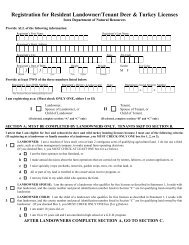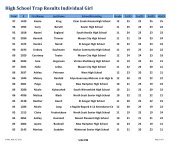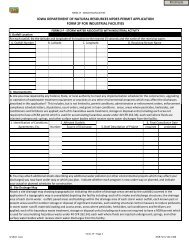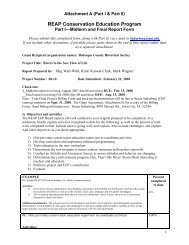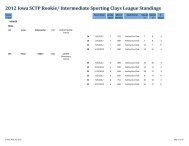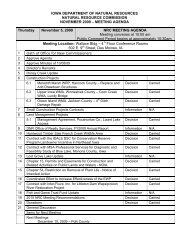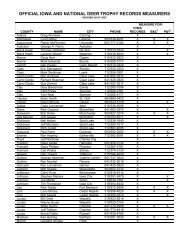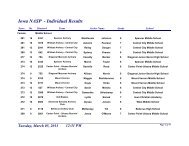Iowa Fishing Regulations - Iowa Department of Natural Resources
Iowa Fishing Regulations - Iowa Department of Natural Resources
Iowa Fishing Regulations - Iowa Department of Natural Resources
Create successful ePaper yourself
Turn your PDF publications into a flip-book with our unique Google optimized e-Paper software.
<strong>Iowa</strong> Fish are Wholesome<br />
Eating fish is an important part <strong>of</strong> a healthy diet for all ages. Fish<br />
are low in saturated fats, contain high quality protein, and important<br />
vitamins and minerals. Some fish can also contain omega-3 fatty acids.<br />
Eating fish can contribute to a healthy heart and a child’s proper growth<br />
and brain development. The American Heart Association recommends<br />
that people enjoy at least 2 servings <strong>of</strong> baked or grilled fish each week,<br />
especially oily fish. Eating fish may protect against a variety <strong>of</strong> diseases<br />
and illnesses in adults, such as cancer, heart disease, dementia, diabetes,<br />
depression, rheumatoid arthritis, psoriasis, prostate cancer, stroke and<br />
autoimmune disease.<br />
Fish Consumption Advisories<br />
Every year, <strong>Iowa</strong> DNR biologists collect edible samples <strong>of</strong> fish for<br />
laboratory analysis. Results <strong>of</strong> this analysis show that most fish are safe<br />
to eat even though trace amounts <strong>of</strong> chemicals may be present in fish<br />
tissue. Mercury and polychlorinated biphenyls (PCBs) are the chemicals<br />
most likely to accumulate in fish and exceed <strong>Iowa</strong>’s risk-based advisory<br />
levels that are based on guidance provided by the <strong>Iowa</strong> <strong>Department</strong> <strong>of</strong><br />
Public Health.<br />
Fish consumption advisories are posted wherever it is confirmed<br />
that <strong>Iowa</strong>’s advisory levels are exceeded (p. 32). Consumption advisories<br />
typically focus on predator and bottom-feeding species. Panfish<br />
(crappie, bluegill, perch) are generally safe to eat with virtually no risk.<br />
The U.S. Environmental Protection Agency (EPA) and Food and<br />
Drug Administration (FDA) recommend that pregnant and nursing women,<br />
those planning to become pregnant and children 12 years or younger<br />
limit their consumption to one meal per week <strong>of</strong> all larger size predator<br />
fish, such as walleye and bass. Predator fish are more likely to have<br />
higher concentrations <strong>of</strong> mercury (see http://www.epa.gov/waterscience/<br />
fishadvice/advice.html); however, consumption <strong>of</strong> panfish by these<br />
higher risk individuals is considered safe unless otherwise posted.<br />
For more information on <strong>Iowa</strong>’s fish consumption advisories, go to<br />
www.iowadnr.gov/<strong>Fishing</strong>/About<strong>Fishing</strong>in<strong>Iowa</strong>.aspx. Visit this website<br />
for the most up-to-date list <strong>of</strong> advisories. New advisories are issued and<br />
existing advisories are removed, based on results <strong>of</strong> annual fish contaminant<br />
monitoring in <strong>Iowa</strong>. To obtain information on the benefits <strong>of</strong> eating<br />
fish or what types <strong>of</strong> fish are safe to eat, visit the <strong>Iowa</strong> <strong>Department</strong> <strong>of</strong><br />
Public Health’s webpage at<br />
http://www.idph.state.ia.us/eh/common/pdf/env/fish_health_issues.pdf32.<br />
31



